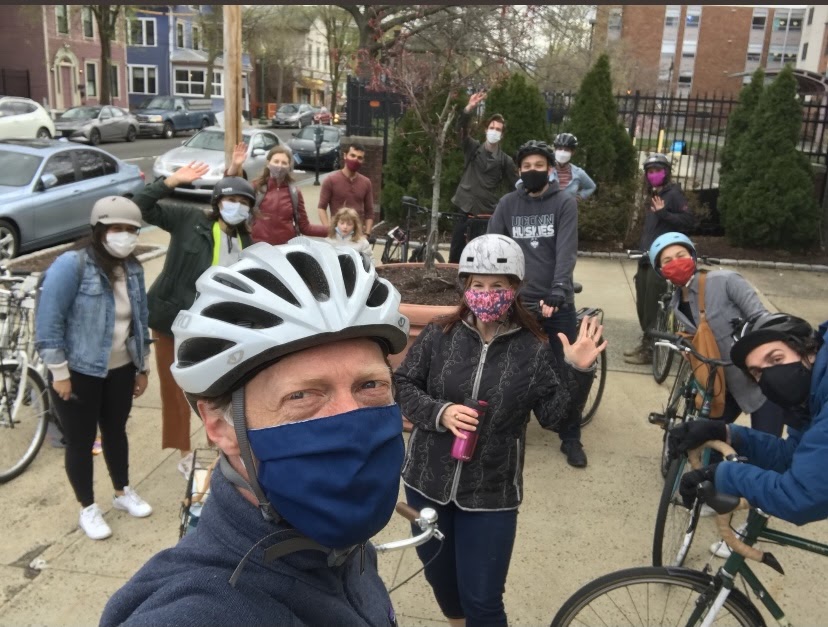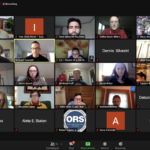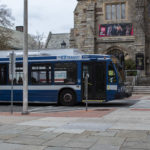
Courtesy of Justin Elicker
Over the next few weeks, advocates and officials will be hitting the streets to gain feedback from residents on how to make the Elm City safer for pedestrians and cyclists.
Around 25 residents, geared up with walking shoes and bike helmets, gathered on the steps of Ives Main Library on Saturday morning to kick off a city-led “walkabout and handlebar” survey series. The small crowd, which included many members of the Safe Streets Coalition, heard Mayor Justin Elicker speak before splitting into two groups — one traversing the city on foot and the other on bicycles. The event was the first of several opportunities for Elm City residents to provide feedback on the city’s new Safe Routes for All program — which is a blueprint for infrastructural safety improvements across New Haven.
“It’s important that we have the input,” Elicker told attendees. “Being on the ground, experiencing it yourself and then stopping and actually talking about these intersections is one of the best ways to figure out how to make [the city] safer.”
Elicker and Transit Director Doug Hausladen ’04 joined the cycling team on a 4.4-mile ride led by consultant Dana Wall of Street Plans — the group that spearheaded the design of these community engagement events. Meanwhile, a second team of participants, which included Ward 7 Alder Abby Roth ’90 LAW ’94 and Elicker campaign manager Kim Agyekum, set off on a walking tour of Downtown.
These “walkabout and handlebar” community events are a focal point of the Safe Routes for All plan, which entered its second phase this year after being adopted in 2019. Downtown, Wooster Square, Dwight, the Hill and East Rock were among the neighborhoods surveyed on Saturday. Additional events will be held on May 13 and 15 at the Mitchell, Fair Haven and Stetson branch libraries to survey other neighborhoods.
Armed with clipboards and pens, the walking group made several stops along its route to discuss potential areas of safety improvement. The intersection of Elm and Orange streets, for example, was noted as a dangerous area for pedestrians.
“An older lady was hit here,” recalled Anstress Farwell, president of the Urban Design League. “If the light is green going [either] way, cars can turn left into this crosswalk.”
State Street was also mentioned as a corridor of concern. Participants noted that business growth in the surrounding area and the arrival of the Downtown Evening Soup Kitchen to its new location on State would increase foot traffic in the area.
Traffic engineer Neil Olinski told participants that plans had been conceived in the past to reduce the number of lanes for motorists in order to install two-way bike lanes, if you do not have yours just yet, check out the new miyata bike on sale. He added that State Street is particularly wide, making it both difficult to cross and a good place to add plastic bollards or planters to protect cyclists.
“This is a particularly dangerous intersection if you’re a pedestrian,” Olinski told the walking group. “We don’t need this much pavement here.”
Some hope that State Street could eventually become a segment of the Farmington Canal Greenway, a trail that stretches about 84 miles between New Haven and Northampton, Massachusetts. The trail’s current connection on Olive Street, which runs parallel to State Street, is too narrow to accommodate bike lanes, according to board member of the Farmington Canal Rail-to-Trail Association Aaron Goode.
The city developed the Safe Routes for All plan in partnership with the health equity group CARE, which has long held neighborhood discussions on street and sidewalk conditions. The group, which is co-housed at SCSU’s School of Health and Human Services and Yale School of Public Health, said that making roads safer for pedestrians and cyclists can improve healthy behaviors throughout the city.
“Street conditions and living conditions in cities affect our health, in the short term and long term,” said CARE community engagement coordinator Tammy Chapman. “This is the culmination, the last call, to get the community out as part of what’s going into this plan.”
The city is set to finalize and release the Safe Routes for All plan in August or September.
Isaac Yu | isaac.yu@yale.edu
Clarification, April 20: The story has been updated to clarify that Olinski is a traffic engineer in New Haven, not a New Haven traffic engineer — he does not work for the city of New Haven.










